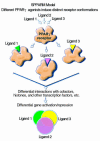Treatment of insulin resistance with peroxisome proliferator-activated receptor gamma agonists
- PMID: 10953021
- PMCID: PMC380259
- DOI: 10.1172/JCI10843
Treatment of insulin resistance with peroxisome proliferator-activated receptor gamma agonists
Figures


Comment in
-
Peroxisome proliferator-activated receptor gamma ligands and atherosclerosis: ending the heartache.J Clin Invest. 2000 Sep;106(5):629-31. doi: 10.1172/JCI10909. J Clin Invest. 2000. PMID: 10974014 Free PMC article. No abstract available.
-
Unraveling the mechanism of action of thiazolidinediones.J Clin Invest. 2000 Dec;106(11):1305-7. doi: 10.1172/JCI11705. J Clin Invest. 2000. PMID: 11104782 Free PMC article. No abstract available.
References
-
- Olefsky, J.M. 1997. Insulin resistance. In Ellenberg and Rifkin’s Diabetes Mellitus: theory and practice. 5th edition. D. Porte and R.S. Sherwin, editors. Medical Examination Publishing Co., New Hyde Park, New York, USA. 151–178.
-
- Reaven GM. Role of insulin resistance in human disease. Diabetes. 1988;37:1595–1607. - PubMed
-
- Taylor SI. Deconstructing type 2 diabetes. Cell. 1999;97:9–12. - PubMed
-
- Warram JH, Martin BC, Krolewski AS, Soeldner JS, Kahn CR. Slow glucose removal rate and hyperinsulinemia precede the development of type II diabetes in the offspring of diabetic parents. Ann Intern Med. 1990;13:909–915. - PubMed
-
- Kruszynska Y, Yu JG, Olefsky JM, Sobel BE. Effects of troglitazone on blood concentrations of plasminogen activator inhibitor 1 in patients with type 2 diabetes and in lean and obese normal subjects. Diabetes. 2000;49:633–639. - PubMed
Publication types
MeSH terms
Substances
LinkOut - more resources
Full Text Sources
Other Literature Sources
Medical

